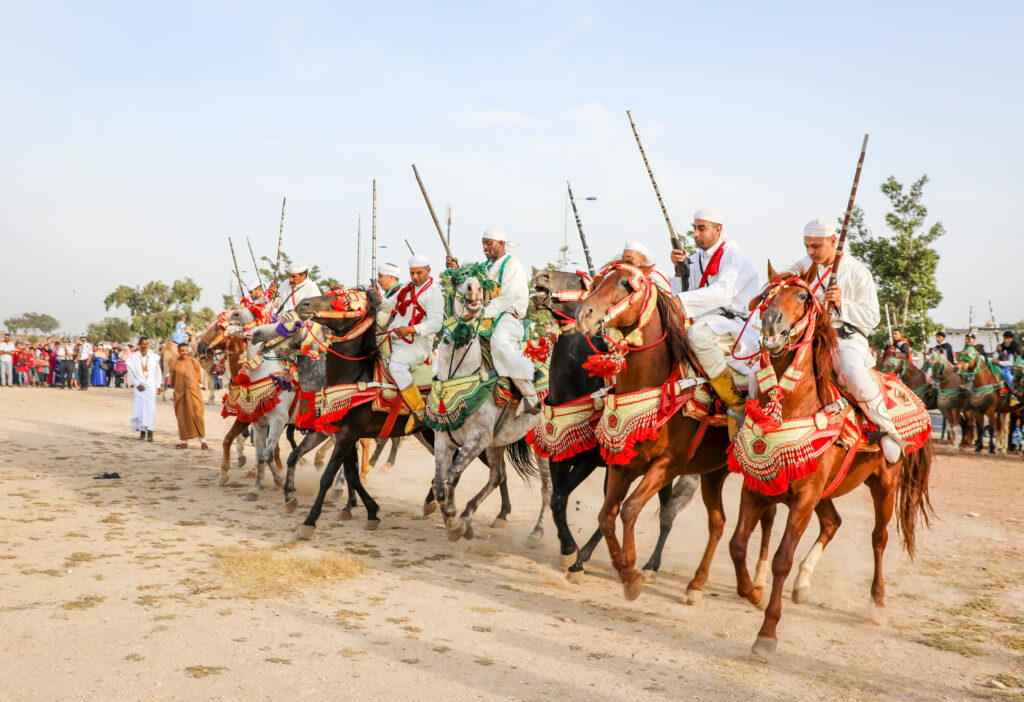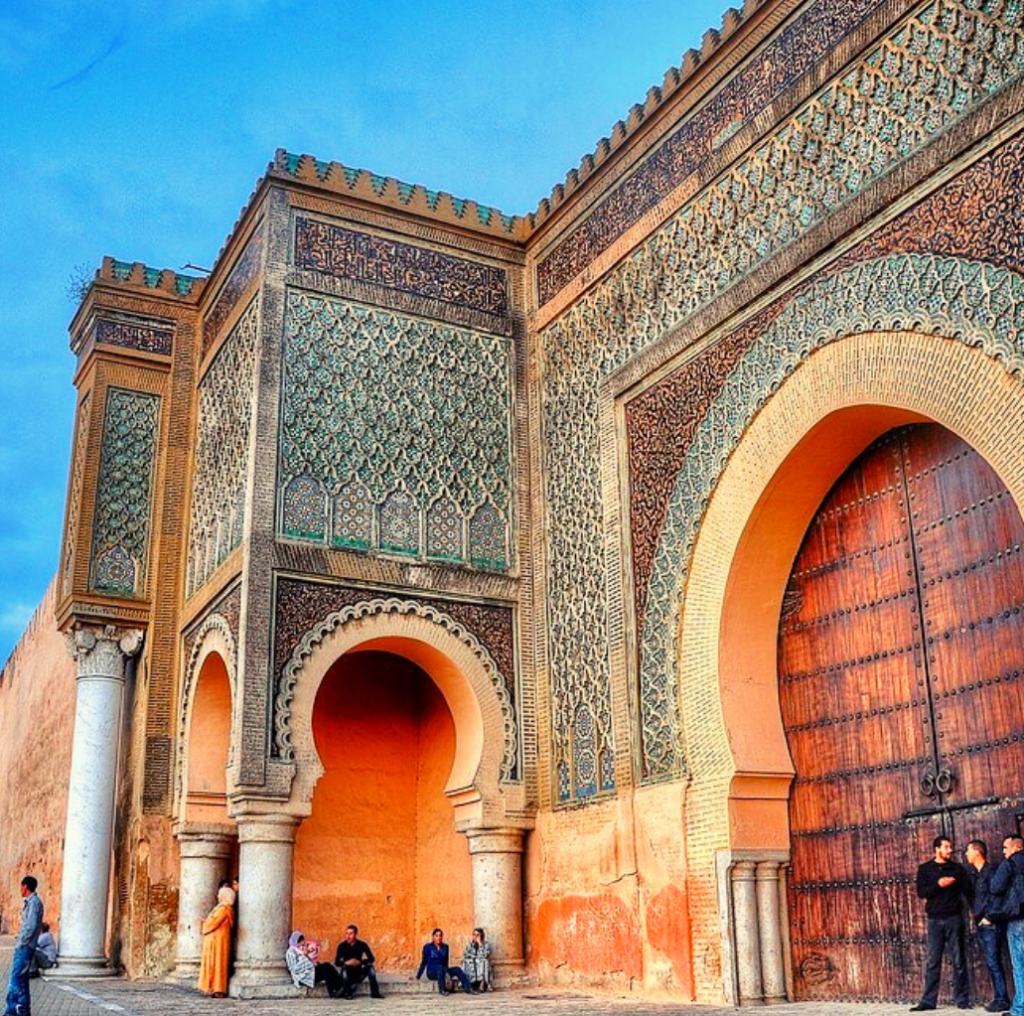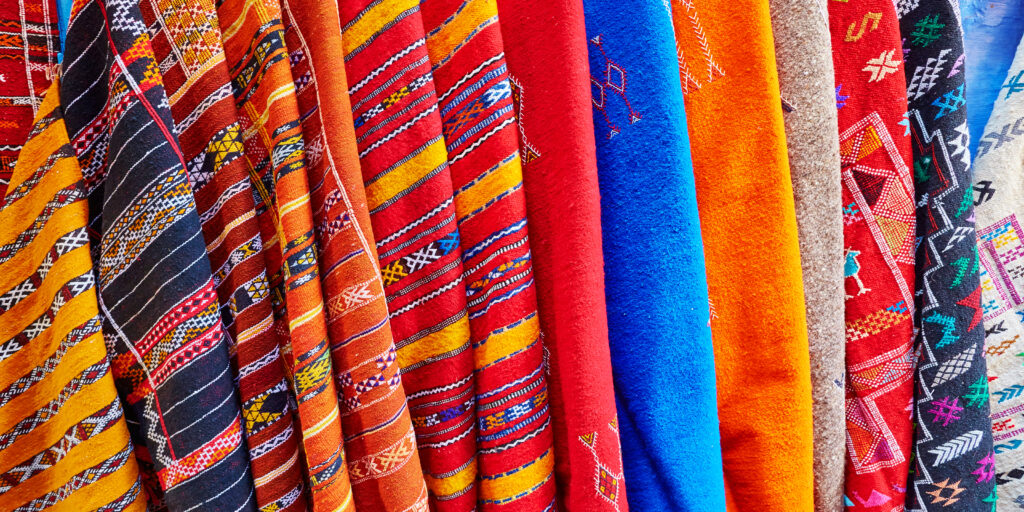
Cara’s Moroccan psychoscape (with a bow to Dali). What’s yours?
(© Aussies In Morocco Tours™)
We aim to design a group tour of Morocco that genuflects to Delacroix, Matisse and Dali (who each spent time there). We’ll offer you the sights and sounds, smells, tastes and feeling, without the overload on learning. We aim to knock you out sensorily, not “informationally” as you might already be saturated with data!

Begin with three nights in Tangier
All three artists spent time in Tangier, which is unsurprising given it is only 14 kilometres from Europe. Delacroix arrived in January 1832 and spent six months there. He saw surrounding cities such as Tetouan and travelled to Meknes to visit the sultan. He saw Fantasia, a splendid horsemanship display, and painted many scenes of colourful local life as all fascinated him after the grey Paris he had left behind. Thus, there were scenes of Jewish brides and Arabs in various poses in the street. We will include a book recording his sketches and paintings as part of your tour, so you can cross reference your own experience with his. (This may be digitised to limit the weight of your luggage.)
We wrote more about Delacroix’s time in Morocco in Part 1 of this blog post series about artists in Morocco here.

Fantasia. You sometimes drive past such a competition as you travel in the country, but trying to find out for holiday-planning purposes the precise dates that these competitions are to be held is problematic. What can we say? That’s Morocco!
In Tangier we will stay at a luxury riad, do an eating tour with a specialist in this field, and you will have the opportunity to sightsee in much the same way as Delacroix, Matisse and Dali before you. For more about what you can see and do in Tangier you can also visit our blog post here.
A day trip to beachy, arty laid-back Asilah would be on the agenda. It is less than an hour from Tangier.
In the evening of that day we will host you for a seafood meal at Saveur de Poisson, a Tangier institution, provided the queue is not too long. There’s no menu; one is served whatever the fishing boats brought in that day. If however the queue there looks tiresome we will go to Le Salon Bleu in the Medina, a small rooftop restaurant in the heart of the kasbah that is also highly recommended.
While in this part of the world we will also offer you the option of two styles of hammam – traditional, where you have to leave your modesty at the front door or Europeanised, which is more private and more luxe. Remember after all, Delacroix was the leader of the opulent Orientalist school of art that loved to paint hammam and harem scenes.
For Cara’s experience of a village hammam see our blog post here.
Three nights in Fez
From Tangier we travel for 3.5 – 4 hours to Meknes where we will visit the city gate – the backdrop to Delacroix’s famous painting of the sultan of Morocco. If it is do-able, we will also visit the Salon International de L’Agriculture au Maroc provided it is possible to see an exhibition of Fantasia there. Then onto Fez, another hour away, for the afternoon and evening and to stay in a restored palace in the ancient Medina and a quiet night in.
(As we will be travelling in 4WD cars and not in a single minibus, if there are some of you who prefer to travel directly to Fez from Meknes after seeing the Gate of Meknes, we will probably be able to arrange this, car seats permitting).

This is the famous Gate of Meknes painted by Delacroix with the Sultan of Morocco riding his horse in the foreground. The Sultan was extraordinarily generous to the French Delegation of which Delacroix was part, even extending to Delacroix the privilege of access to the inner sanctum of his Palace so that he could draw sketches of domestic life there. We think that the Gate has lost none of its grandeur as this photograph demonstrates. Photograph: © Maevanwy McAvoy.
As Fez is the food capital of Morocco we will host a couple of special dinners here. We will book a table at Nur, a Michelin Star rated restaurant. There is also another restaurant that we know of, where they have traditional dancing and music every night amongst the mosaic-rich interior – that will be a lot of fun too. A tour of the ancient Medina is a must and we (or our trusted, local, certified guide) can take you to a few genuine artisanal cooperatives, one of which has the Moroccan Royalty Seal of Approval. There are also a few interesting day trips from Fez that we can offer like a visit to the cave houses of Bhalil, around 40 minutes from Fez.
Then it is onto Marrakech. This will be a day’s driving in effect. Going by train is also a possibility and some tour groups do it. However having looked into it, we don’t share their apparent confidence in the efficacy of lengthy train trips in Morocco. Toilet paper is often missing in action for one thing!
Three nights in Marrakech
Matisse loved the interiors in Morocco and the everyday scenes fascinated him. He was profoundly influenced by the decorative elements of Morocco especially in his efforts to use colour as pure expression. One need only compare his paintings to traditional Moroccan carpets to see this. (You may have already visited the Matisse museum at the French Riviera, where he spent a lot of his life, and so already know what we are talking about).

This array of Moroccan carpets makes it easy to see the connection between the decorative aspects of Matisse’s later art and the influence of Morocco upon his oeuvre.
Prepare yourself for an interesting time here in Marrakech. On arrival day, you’ll have a chance to eat dinner at the famous night markets, led by a local foodie expert with whom we have previously worked. The next day can be a quiet rest at an amazingly atmospheric, mosaic-laden riad dating back centuries. Or you can make a morning visit to the Majorelle Gardens (created by French painter Jacques Majorelle in the 1920s).
For lunch, there are so many options in Marrakech. “Les Jardins du Lotus” has chic 1970s-style décor and is buzzy. “Le Jardin” Restaurant on the other hand is a cool retreat from the bustle of the Medina. The latter serves a wide variety of western and Moroccan food and its vegetarian highlight includes the carrot hummus with paprika and zucchini and feta fritters.
In the afternoon, you can have a one-hour perfume making session with a master perfumer located in the Medina. Or as an alternative to you making your own signature perfume, the tour group can do an afternoon tour of the ancient Medina. This would be flexible, but a good one could include the garden and Palace at Le Jardin Secret, ChiChaoua Tea Room for a drink and Riad Yima for way-out artwork and designs of Hassan Hajjaj Morocco’s most renowned artist.
For those with the enthusiasm to walk a little further and stand a little longer there are the eerie Tombeaux Saadiens, a mid-16th century burial complex that was uncovered in 1917. We would also recommend concluding the walking tour of the ancient Medina by visiting Palais Bahia with its wonderful mosaics and harem rooms. Finally we could all meet at Restaurant El Bahia nearby, which has a little-known rooftop terrace, serves alcohol and from which you can enjoy the sunset over Marrakech.
We can also arrange a shopping tour with a western lady who lives locally and knows the artisans (so you’ll feel a bit more comfortable for example, when you visit wood decorators whose artisanal output again resonates with Matisse). However an organised shopping tour is not obligatory and we will sound out the group on tour before arranging any such shopping expedition.
We will also give you some beautiful cross referencing material, so the links between Matisse’s use of patterns and colour and the Moroccan decorative styles are to hand too.
The next day, we will travel 30 minutes from Marrakech to Ourika in the High Atlas Mountains, where you’ll have lunch, sitting at a table with your feet “in” (yes “in”) a river. (Bring thongs or equivalent!) Or if the weather is a bit cooler, we will take you to a saffron farm for a very leisurely (and saffron-coloured, flavoured and scented) lunch instead at a farm owned and operated by a German-Swiss lady.
If we do go to the saffron farm for lunch, then we would be able to pop into Anima Gardens which is just close by. It is charming, with some artworks of noteworthy artists including a sculpture by Rodin.
If you want, whilst we are in the mountains we can show you where to buy carpets in the styles and colours that inspired Matisse from the ladies who make them, rather than via intermediaries. We know one lady in particular whose carpets are uncannily similar to Matisse’s palette and iconography. Dinner will again be at the riad after a busy day out.
Marrakech has a splendid tradition of oral story-telling, usually by men in the local square who made a living from it. Cafe Clock, a funky cafe owned by European expatriates, sometimes has oral storytelling evenings where the stories are recited in English. If we can coordinate it, we will certainly offer this as a dinner option for one of the evenings we are in Marrakech, instead of dining at the riad.
(More about Matisse’s time in Morocco appears in Part 1 of this 3-Part blog post series on artists in Morocco here.).
Then it is onto Dali’s desert scenes, which we have already touched upon in Part 2 of this 3-Part blog post series here.
A lovely book (again perhaps digitised) of Dali’s paintings containing assorted landscape scenes will be included in your tour pack.
Seeing as it is likely to be a 14-night/15-day tour, if you would like to join us for only part of the tour, for example, Tangier, Fez and Marrakech (9-nights/10-days) or if you’d like to join us as we depart Marrakech and come to the desert with us (5-nights/6-days), or some other variation, let us know and we will see what we can do.
Also, see costings for full tour at end of Part 3 (2nd leg of proposed journey) of this 3 Part blog series here.
Published November 2020
